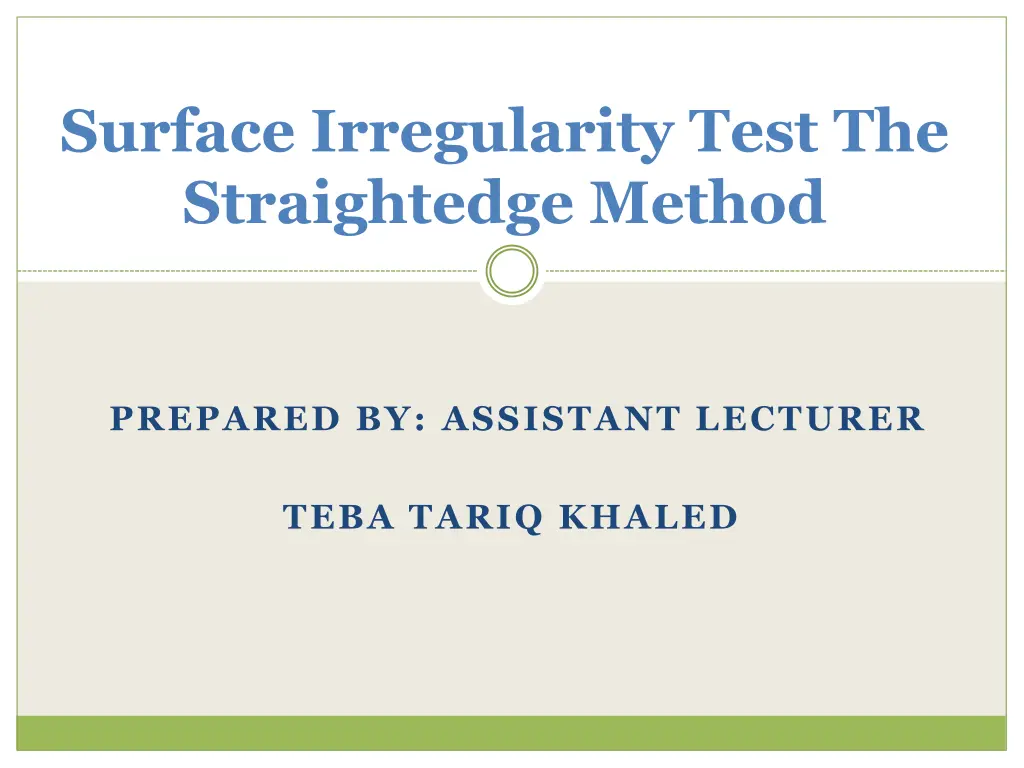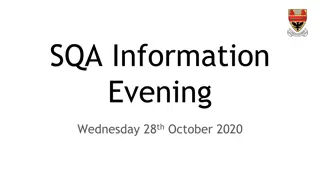
Surface Irregularity Test: The Straightedge Method
Learn about the Surface Irregularity Test using the Straightedge Method to measure rut depth on pavement surfaces. Understand the purpose, apparatus needed, procedures for placement, gauge placement, and rut-depth measurement, as well as the presentation of results.
Download Presentation

Please find below an Image/Link to download the presentation.
The content on the website is provided AS IS for your information and personal use only. It may not be sold, licensed, or shared on other websites without obtaining consent from the author. If you encounter any issues during the download, it is possible that the publisher has removed the file from their server.
You are allowed to download the files provided on this website for personal or commercial use, subject to the condition that they are used lawfully. All files are the property of their respective owners.
The content on the website is provided AS IS for your information and personal use only. It may not be sold, licensed, or shared on other websites without obtaining consent from the author.
E N D
Presentation Transcript
Surface Irregularity Test The Straightedge Method PREPARED BY: ASSISTANT LECTURER TEBA TARIQ KHALED
Purpose: Rutted pavement surfaces may have an adverse influence on characteristics and may drainage, which may reduce friction properties and contribute to hydroplaning. This test method is applied to measure the rut depth at a chosen location in a pavement surface using a straightedge and a gauge. vehicle impede handling surface
Apparatus: 1. Straightedge: Width: straightedge shall be at least 20 mm width but not more than 75 mm (3.0 in.) wide in the measurement plane. Length: The preferred lengths of the straightedge are either 2 m or 3. The length shall ensure that the straightedge spans the two highest points on either side of the rut. The minimum length shall be at least 1.73 m. 2. Gauge: The rut-depth measuring gauge shall be graduated to 1 mm or finer. The bottom rectangular surface of the
Procedure Straightedge Placement: 1. A- Place the straightedge across the rut. Allow the straightedge to rest upon the pavement at two contact areas, such that sliding the straightedge along its length in both directions will not change the contact areas on the pavement. B- Place the straightedge in a plane perpendicular to the direction of traffic movement. The bottom surface of the straightedge shall be parallel to the longitudinal slope of the pavement. C- The longitudinal interval between successive straightedge placements should be related to the precision required for the use of the data. 2. Gauge Placement: Place the gauge between the two contact areas perpendicular to the reference plane created by the bottom of the straightedge and perpendicular to the longitudinal slope of the pavement. The bottom of the gauge shall be in contact with the pavement at the time of the measurement.
Procedure 3. Rut-Depth Measurement: A- Measure the distance between the bottom surface straightedge and after the gauge has been placed. B- Measurements should be made to the nearest graduation of the gauge. A sufficient measurements should along the straightedge to determine the greatest distance between the straightedge and the pavement. The greatest distance measured between the two contact areas or along the full straightedge length. of the the pavement number be of made can be
Results The cross-section of pavement can be presented as this figure.






















